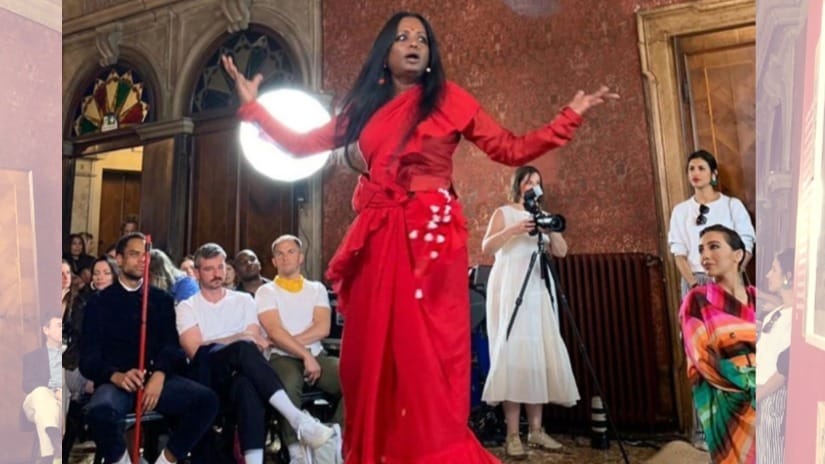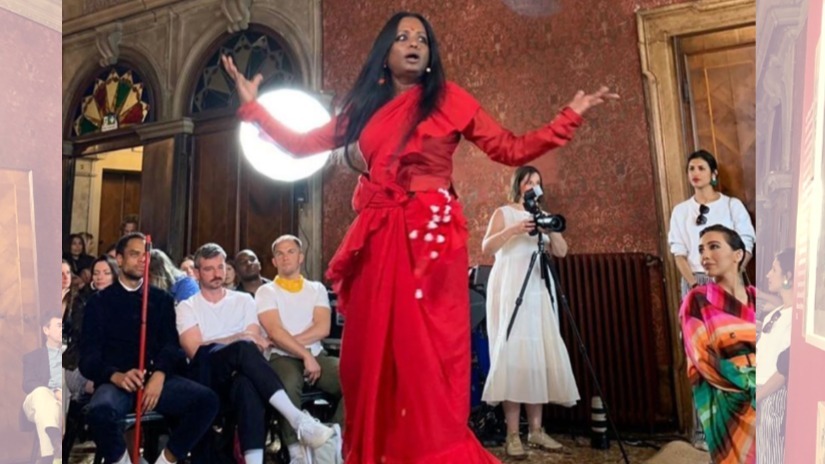On May 10, during the opening week of the 2019 Venice Biennale, Delhi-based artist Mithu Sen presented her newest performance piece, (Un)Mansplaining. It was part of a group show — aptly titled ‘She Persists’ — that brought together 20 international rebellious female voices, at the Palazzo Benzon on the Grand Canal, curated by Mashael Al Rushaid and Sona Datta for London’s Heist gallery. Once again, Sen performed using aphasia-resembling non-language as her medium, wearing a vermillion outfit that consciously highlighted the dark intonations of her complexion, thus playing with how she is frequently received and labelled in the Western art world as exotic. Firstpost spoke to Sen upon her return to Delhi from Venice. She shared with us the intentions behind (Un)Mansplaining, a performance that satirised the oppressive gaze and tongue of the male art critic through the triumphant, exultant privileging of female irrepressibility and the reclaiming of feminist agency. Between the conception of the piece, (Un)Mansplaining, and its execution in Venice, what were the fears, challenges, barriers that you encountered, either intellectually or logistically? I was provoked into doing a piece playing with the role of exotica and cult when a male art writer wrote about one my performances as if I were an unworldly, possessed woman, which is his/their fantasy about positioning me as an empowered witch/goddess/woman. It’s easier to do that than to really try to understand the ‘voice’ behind such bodies, which is to me a political act, a matter of existential agency. It is a conscious choice, a chosen surrender. That kind of critique is about not accepting my real agency but objectifying my body instead. This is how the idea came to be conceptualised as (Un)Mansplaining, a performance directly addressing the back story. I have no fears, but I always am extremely vulnerable because I physically project myself and am constantly being labeled as an exotic presence by the so-called intellectual critics, which empowered me more to be fearless and play the same role, using humour to give it back to them… exhaust them fully, and then have a mischievous laugh in the green room. I do everything an Unhuman can do. [caption id=“attachment_6727711” align=“alignnone” width=“825”]  From Mithu Sen’s (Un)Mansplaining, Venice, 2019. Image courtesy Mithu Sen[/caption] You performed in gibberish or non-language upon a soundtrack constituted by audio excerpts of men pontificating. How did you go about stitching that soundtrack? What were some of your sources? This performance (Un)Mansplaining involves pre-recorded excerpts from a plethora of male voices collected from lectures/comments on art, feminism and feminist art that have been collaged onto a soundtrack. Thus, the style of narrative speech is one we are so familiar with, from documentaries and other commentaries. This soundtrack played in the background while I intervened, raising my own voice with non-language gibberish, using empathetic, nonsense speech, delivering frustration to the onlookers who sought to grasp any meaning. For the soundtrack, my main source was YouTube lectures on art/feminist art etc. by different male art scholars and critics. I listened to a number of lectures and selected a few excerpts from among them. I started noting down the most suitable words/sentences without their immediate context to create an abstract but convincing ‘script’, started working with a sound editor to create my collage. I also added atmospheric music and moments of silence for the whole storyline. As you know, I don’t do any rehearsal before any of my on-site performances, but create a narrative/background with the content I develop for each performance project. Like the film for the Guggenheim project [‘ Aphasia’ (2016)], my slide show presentation for IAF project [‘ 100 (Un)Silent Ways’ (2019)] or this soundtrack for my Venice project. So, non-language execution remains a constant tool for establishing my physical/visceral presence, but the back story is my main content that I use to address the specific platform to which I am invited. At Venice, you consciously staged yourself as the ‘exotic, dark-skinned goddess’ you are frequently positioned as by various elements and forces within the art world; using your ‘body as a cult’, as you said. You were playing with the perception of you as a ‘possessed’ being; and intriguingly, a ‘possessed’ being is one, it could be argued, that no longer has agency, because her body is being temporarily controlled by forces that are external that take residence internally, within the self. It comes across as a powerful provocation against the insidious ways in which female artists are frequently slotted, or outrightly discredited by the so-called critical or intellectual ‘male gaze’. Can you walk us through the genesis of such a subversive performative act, perhaps amongst your most candidly ‘hysterical’ so far? It’s not only the ‘male gaze’, but the whole politics of projection or myth-making, identity-creating politics for today’s world to feed the market mainly through the internet and social media, where exotica exalts the female body to cultness, especially from the global south to the west. Social media has been my medium/source of contemporary human/market psyche since the last few years. Viewers always inject their biases into whatever they see, I try to indulge that so my presence is something explicitly convincing. So, before and after the very performance on site, I post about my position as an exotic goddess, playing the role, breaking out of usual patterns of behavior using my body as a cult on this platform as a provocation/trap for the world. It fed well since the show itself was based on feminist themes. Keywords worked! The deeper the viewers’ (the onsite viewer and the online viewer, along with the live streaming) fantasy of the exotic goddess is fetishised and sexualised, the more likely they are to think I am possessed. But, in fact, it is they who are possessed with the idea of fantasy. I am playing with them all. I am playing with their need to always explain to me, to control and overshadow me. I wear my exotica and singular vulnerability with pride. At the end of it, were there elements of the audience reception that proved the point you were making, about the Western art world’s orientalist perception and reception of third-world female bodies? In a way it is as literal as that, but I think it is even beyond that perception. I should not limit myself only with the third-world exotica, playing a gender political/geopolitical role for the Western art world but to raise the question of how the whole myth-making policy works for the global market and how audience-consumers are easily trapped with that optic missing the real haptic. How they only grab the ‘by-products’ of the real thing. In my practice, the cognitive and sensory projections in the form of life and human experiences are the actual material that produces my art. The output in the format of drawing, poetry, sculpture, installation, and performance is what I call byproducts of art making. I use the word byproduct to term the tactile manifestations of my art. The intention is to relocate the focus on the conceptual — the mind, emotions, and senses that produce the art practice, and the byproducts are just a remnant of this process. [caption id=“attachment_6727791” align=“alignnone” width=“825”]  From Mithu Sen’s (Un)Mansplaining, Venice, 2019. Image courtesy Mithu Sen[/caption] Your performances engage very directly with the process of othering. Do you consciously ‘other’ yourself from your audiences by exaggerating or heightening the aspects of your identity that make you ‘other’? Are you at any point interested in building perceptual bridges, or do you find you revel in the differences? One of my real challenges is to understand the body well and treat it well. Body means not just the flesh and blood but the entire nervous system and subconscious too. I keep my physical body free to truthfully embrace the instinctual part organically. Therefore no rehearsal is prepared which keeps me open at that very moment to respond/react instinctually with the immediate surroundings while keeping a well-thought contextual background with its specific social and political context (power, brutality, visceral matters, desire, danger, sadness, rage, political terror, male-induced violence etc.) as narrative clues. In my practice, consciously keeping self/body/mind instinctual is the real intellectual feat rather than delivering the baggage of information which is already available on Google! I don’t become an ‘other’ while am performing because it’s a true, conscious self which is away from the social conditioning and is organically, liberatingly coming out and I am not resisting that spontaneous action. I think rather than when I am living a codified, constructed civilised life, that’s more being a self with ‘otherness’, where every act is taught/thought/instructed. Rebecca Solnit, in A Field Guide to Getting Lost offers a definition of what it means to be lost: “To lose yourself — a voluptuous surrender, lost in your arms, lost to the world, utterly immersed in what is present so that its surroundings fade away. In Benjamin’s terms, to be lost is to be fully present, and to be fully present is to be capable of being in uncertainty and mystery. And one does not get lost but loses oneself, with the implication that it is a conscious choice, a chosen surrender, a psychic state achievable through geography. That thing the nature of which is totally unknown to you is usually what you need to find, and finding it is a matter of getting lost… Lost really has two disparate meanings. Losing things is about the familiar falling away, getting lost is about the unfamiliar appearing.” Finally, how do you prepare yourself emotionally and intellectually for a performance of this nature and scale? I keep myself open for an unknown, unique experience that will never happen again to my body, where the manifestation and outcome cannot be known in advance. It is one-time and ephemeral. I completely trust my consciousness, my cognitive and sensory feelings in my body. I concentrate to listen to what my flowing blood and the whole nervous system is letting me explore — the liberty and freedom of the body. It is transitory, it’s spontaneous, playful and often interactive. And it’s always an experience. It isn’t, however, a tangible object. To me, performing within the crowd and audience, seeing them frozen at my ‘otherly’/‘unworldly’-ness, I actually feel immensely empowered and confident that no generalised robotic/AI data can really define my very basic humanly instinct that only I can deliver, thus challenging constructed institutional hierarchies.
Artist Mithu Sen’s (Un)Mansplaining satirises the oppressive gaze and tongue of the male art critic through the triumphant, exultant privileging of female irrepressibility and the reclaiming of feminist agency.
Advertisement
End of Article


)
)
)
)
)
)
)
)
)



